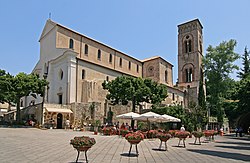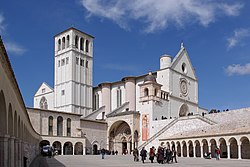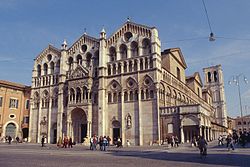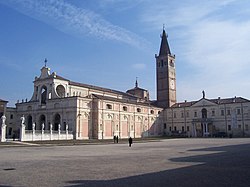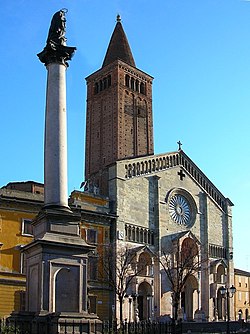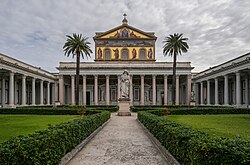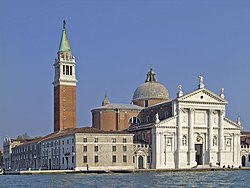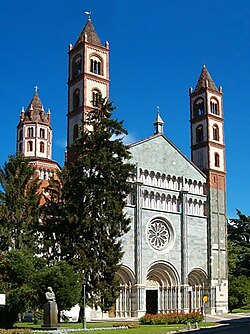

The following is a list of Roman Catholic basilicas in Italy, listed by diocese and comune. The date of designation as a basilica is in parentheses.
Contents
- Acerenza
- Acerenza 2
- Tolve
- Acerra
- Santa Maria a Vico
- Acireale
- Acireale 2
- Castiglione di Sicilia
- Randazzo
- Riposto
- Acqui
- Acqui 2
- Adria – Rovigo
- Adria
- Lendinara
- San Bellino
- Sant'Apollinare
- Agrigento
- Agrigento 2
- Sciacca
- Albano
- Albano Laziale
- Anzio
- Marino
- Nettuno
- Albenga – Imperia
- Imperia
- Pietra Ligure
- Alessandria
- Quargnento
- Alghero – Bosa
- Cuglieri
- Alife – Caiazzo
- Caiazzo
- Piedimonte Matese
- Altamura – Gravina – Acquaviva delle Fonti
- Gravina in Puglia
- Amalfi – Cava de' Tirreni
- Cava de' Tirreni
- Minori
- Ravello
- Anagni – Alatri
- Alatri
- Anagni
- Ancona – Osimo
- Ancona
- Osimo
- Arezzo – Cortona – Sansepolcro
- Arezzo
- Bibbiena
- Chiusi della Verna
- Cortona
- Sansepolcro
- Ariano Irpino – Lacedonia
- Ariano Irpino
- Ascoli Piceno
- Ascoli Piceno 2
- Assisi – Nocera Umbra – Gualdo Tadino
- Assisi
- Gualdo Tadino
- Aversa
- Grumo Nevano
- Avezzano
- Pescina
- Trasacco
- Bari – Bitonto
- Bari
- Bitonto
- Belluno – Feltre
- Belluno
- Cortina d'Ampezzo
- Feltre
- Benevento
- Benevento 2
- Vitulano
- Bergamo
- Alzano Lombardo
- Bergamo 2
- Clusone
- Gandino
- Pontida
- Vercurago
- Biella
- Biella 2
- Bologna
- Bologna 2
- Cento
- Bolzano – Brixen
- Brixen
- Deutschnofen
- Vahrn
- Brescia
- Bagnolo Mella
- Brescia 2
- Concesio
- Montichiari
- Pralboino
- Verolanuova
- Brindisi – Ostuni
- Brindisi
- Mesagne
- San Vito dei Normanni
- Cagliari
- Cagliari 2
- Quartu Sant'Elena
- Caltagirone
- Caltagirone 2
- Militello in Val di Catania
- Camerino – San Severino Marche
- Camerino
- Campobasso - Bojano
- Castelpetroso
- Capua
- Capua 2
- Carpi
- Carpi 2
- Casale Monferrato
- Casale Monferrato 2
- Serralunga di Crea
- Caserta
- Maddaloni
- Cassano all'Ionio
- Cassano all'Ionio 2
- Castrovillari
- Catania
- Biancavilla
- Catania 2
- Pedara
- Catanzaro – Squillace
- Catanzaro
- Squillace
- Cefalù
- Cefalù 2
- Collesano
- Montemaggiore Belsito
- Cerignola – Ascoli Satriano
- Cerignola
- Cerreto Sannita – Telese – Sant'Agata de' Goti
- Guardia Sanframondi
- Cesena – Sarsina
- Cesena
- Sarsina
- Chiavari
- Chiavari 2
- Cogorno
- Lavagna
- Rapallo
- Santa Margherita Ligure
- Sestri Levante
- Chieti – Vasto
- Manoppello
- Chioggia
- Chioggia 2
- Città di Castello
- Città di Castello 2
- Civita Castellana
- Castel Sant'Elia
- Città di Castello 3
- Civita Castellana 2
- Como
- Como 2
- Tirano
- Conversano – Monopoli
- Alberobello
- Conversano
- Monopoli
- Cosenza – Bisignano
- Cosenza
- Dipignano
- Paola
- Crema
- Crema 2
- Cremona
- Caravaggio
- Crotone – Santa Severina
- Crotone
- Fabriano – Matelica
- Fabriano
- Faenza – Modigliana
- Faenza
- Fano – Fossombrone – Cagli – Pergola
- Cagli
- Fano
- Pergola
- Serra Sant'Abbondio
- Fermo
- Fermo 2
- Ferrara – Comacchio
- Comacchio
- Ferrara
- Fidenza
- Monticelli d'Ongina
- Fiesole
- Reggello
- San Giovanni Valdarno
- Florence
- Florence 2
- Impruneta
- Vaglia
- Foggia – Bovino
- Bovino
- Foggia
- Forlì – Bertinoro
- Forlì
- Forlimpopoli
- Fossano
- Fossano 2
- Frascati
- Frascati 2
- Frosinone – Veroli – Ferentino
- Veroli
- Gaeta
- Gaeta 2
- Lenola
- Genoa
- Arenzano
- Camogli
- Ceranesi
- Genoa 2
- Gorizia
- Aquileia
- Grado
- Monfalcone
- Grosseto
- Grosseto 2
- Gubbio
- Gubbio 2
- Iglesias
- Sant'Antioco
- Imola
- Imola 2
- Lugo
- Ischia
- Casamicciola Terme
- Forio
- Lacco Ameno
- Jesi
- Jesi 2
- Lamezia – Terme
- Conflenti
- Lanciano – Ortona
- Lanciano
- Ortona
- L'Aquila
- L'Aquila 2
- La Spezia – Sarzana – Brugnato
- Sarzana
- Lecce
- Lecce 2
- Livorno
- Livorno 2
- Locri – Gerace
- Gerace
- Lodi
- Lodi 2
- Sant'Angelo Lodigiano
- Loreto
- Loreto 2
- Lucca
- Lucca 2
- Lucera – Troia
- Lucera
- Troia
- Viareggio
- Macerata – Tolentino – Recanati – Cingoli – Treia
- Macerata
- Recanati
- Tolentino
- Manfredonia – Vieste – San Giovanni Rotondo
- Manfredonia
- Monte Sant'Angelo
- Vieste
- Mantua
- Castiglione delle Stiviere
- Curtatone
- Goito
- Gonzaga
- Mantua 2
- San Benedetto Po
- Massa Carrara – Pontremoli
- Massa
- Massa Marittima – Piombino
- Massa Marittima
- Matera – Irsina
- Matera
- Mazara del Vallo
- Mazara del Vallo 2
- Melfi – Rapolla – Venosa
- Melfi
- Messina – Lipari – Santa Lucia del Mela
- Barcellona Pozzo di Gotto
- Lipari
- Messina
- Montalbano Elicona
- Taormina
- Milan
- Abbiategrasso
- Besana in Brianza
- Busto Arsizio
- Cantù
- Desio
- Gallarate
- Imbersago
- Lecco
- Legnano
- Magenta
- Melegnano
- Milan 2
- Missaglia
- Monza
- Rho
- Saronno
- Seregno
- Sesto San Giovanni
- Somma Lombardo
- Treviglio
- Varese
- Mileto – Nicotera – Tropea
- Mileto
- Seminara
- Vallelonga
- Modena – Nonantola
- Fiorano Modenese
- Modena
- Molfetta – Ruvo – Giovinazzo – Terlizzi
- Molfetta
- Mondovì
- Vicoforte
- Monreale
- Monreale 2
- Monte Cassino
- Cassino
- Pescocostanzo
- Napoli (Naples)
- Afragola
- Casoria
- Ercolano
- Naples
- Torre del Greco
- Nardò – Gallipoli
- Gallipoli
- Nardò
- Parabita
- Nicosia
- Assoro
- Nicosia 2
- Nocera Inferiore – Sarno
- Nocera Inferiore
- Nocera Superiore
- Pagani
- Nola
- Nola 2
- Torre Annunziata
- Visciano
- Noto
- Modica
- Novara
- Gozzano
- Novara 2
- Orta San Giulio
- Re
- Varallo Sesia
- Verbania
- Oria
- Francavilla Fontana
- Oria 2
- Oristano
- Oristano 2
- Orvieto – Todi
- Bolsena
- Orvieto
- Todi
- Otranto
- Galatina
- Otranto 2
- Padua
- Este
- Padua 2
- Teolo
- Palermo
- Altavilla Milicia
- Monreale 3
- Palermo 2
- Santa Flavia
- Palestrina
- Genazzano
- Palestrina 2
- Parma
- Fontanellato
- Parma 2
- Patti
- Patti 2
- Pavia
- Pavia 2
- Perugia – Città della Pieve
- Perugia
- Pesaro
- Pesaro 2
- Pescara – Penne
- Pescara
- Pescia
- Montecatini Terme
- Monsummano Terme
- Piacenza – Bobbio
- Bedonia
- Bobbio
- Piacenza
- Piazza Armerina
- Piazza Armerina 2
- Pinerolo
- Pinerolo 2
- Pisa
- Pisa 2
- Pistoia
- Pistoia 2
- Pompei
- Pompei 2
- Potenza – Muro Lucano – Marsico Nuovo
- Avigliano
- Potenza
- Viggiano
- Pozzuoli
- Pozzuoli 2
- Prato
- Prato 2
- Ragusa
- Comiso
- Monterosso Almo
- Vittoria
- Ravenna – Cervia
- Ravenna
- Reggio Calabria – Bova
- Reggio Calabria
- Reggio Emilia – Guastalla
- Boretto
- Reggio Emilia
- Rieti
- Rieti 2
- Rome
- Rome 2
- Salerno – Campagna – Acerno
- Campagna
- Salerno
- San Benedetto del Tronto – Ripatransone – Montalto
- Montalto delle Marche
- Ripatransone
- San Benedetto del Tronto
- San Marco Argentano – Scalea
- San Sosti
- Sant'Angelo dei Lombardi – Conza – Nusco – Bisaccia
- Caposele
- Sassari
- Sassari 2
- Savona – Noli
- Finale Ligure
- Savona
- Senigallia
- Senigallia 2
- Sessa Aurunca
- Sessa Aurunca 2
- Siena – Colle di Val d'Elsa – Montalcino
- Asciano
- Poggibonsi
- San Gimignano
- Siena
- Siracusa
- Siracusa 2
- Sora – Aquino – Pontecorvo
- Aquino
- Pontecorvo
- Settefrati
- Sorrento – Castellammare di Stabia
- Castellammare di Stabia
- Meta
- Piano di Sorrento
- Sorrento
- Spoleto – Norcia
- Cascia
- Norcia
- Subiaco
- Subiaco 2
- Sulmona – Valva
- Sulmona
- Taranto
- Martina Franca
- Taranto 2
- Teano – Calvi
- Roccamonfina
- Teggiano – Policastro
- Latronico
- Maratea
- Tempio – Ampurias
- Olbia
- Teramo – Atri
- Atri
- Isola del Gran Sasso
- Teramo
- Termoli – Larino
- Larino
- Termoli
- Tortona
- Broni
- Tortona 2
- Trani – Barletta – Bisceglie
- Barletta
- Bisceglie
- Trani
- Trapani
- Alcamo
- Trapani 2
- Trento
- Sanzeno
- Trento 2
- Treviso
- Treviso 2
- Trieste
- Trieste 2
- Turin
- Castelnuovo Don Bosco
- Turin 2
- Tursi – Lagonegro
- Tursi
- Udine
- Cividale del Friuli
- Udine 2
- Ugento – Santa Maria di Leuca
- Castrignano del Capo
- Urbino – Urbania – Sant'Angelo in Vado
- Sant'Angelo in Vado
- Urbino
- Vallo della Lucania
- Castellabate
- Velletri – Segni
- Velletri
- Venice
- Venice 2
- Ventimiglia – San Remo
- Sanremo
- Taggia
- Vercelli
- Vercelli 2
- Verona
- Caprino Veronese
- Lonato del Garda
- Verona 2
- Vicenza
- Vicenza 2
- Vigevano
- Mortara
- Viterbo
- Acquapendente
- Grotte di Castro
- Montefiascone
- Orte
- Viterbo 2
- Vittorio Veneto
- Follina
- Motta di Livenza
- Volterra
- Volterra 2
- See also
- References
- External links






